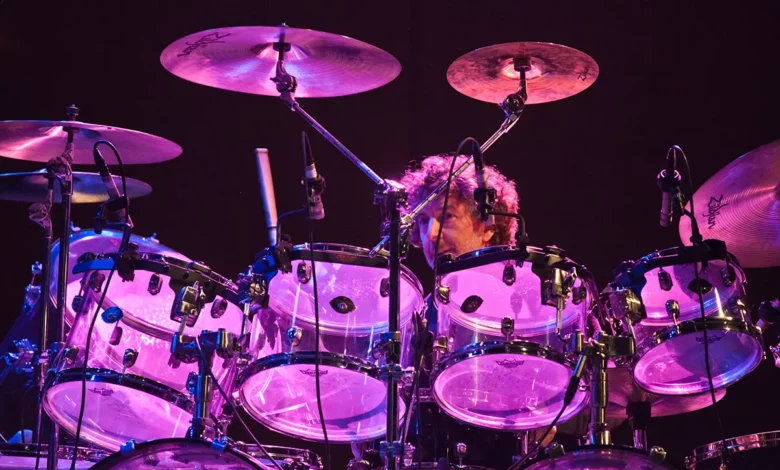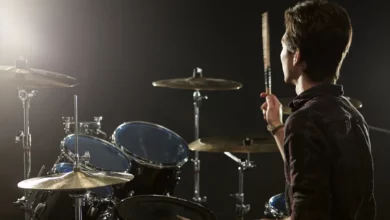
We may earn a commission from the affiliate links on this site. Learn more›
I used to teach ostinatos to my elementary schoolers back when I was a K-2 music teacher in a rural school district. Anyone can learn to play an ostinato, even if you aren’t a musician! This lighthearted introductory example is similar to what I’ve shown to my kids in the classroom.
Even if you don’t know what an ostinato is, you’ve undoubtedly heard one. So, let’s get to it: What is an ostinato, Aleah?!
What is an Ostinato?
An ostinato is a short, repetitive motif in music. An ostinato can be tonal or rhythmic. One example of an ostinato in the context of drumming is the iconic Bo Diddley beat.
Types of Ostinato
Ostinatos (aka ostinati) can be divided into three main categories:
- Melodic
- Harmonic
- Rhythmic
The three are self-explanatory:
- Melodic ostinatos repeat a given set of notes.
- Harmonic ostinatos repeat harmony.
- A rhythmic ostinato repeats a specific rhythm.
What is interesting about these distinctions is that the rhythm of a melodic ostinato can change, and it is still considered an ostinato. The same goes for a harmonic ostinato and a rhythmic ostinato: A harmonic ostinato’s rhythm can change, and a rhythmic ostinato’s tones/notes can vary: If the other element is altered, it still keeps being an ostinato.
The Origin of the Ostinato
The word ‘ostinato,’ like many other music terms, comes from Italian. Ostinato means ‘stubborn,’ probably because it just keeps going and going and going… Ostinatos often continue for the entirety of a song or compositional piece.
It’s hard to say when the first ostinato was created, but we know that we heard them a lot around 1400 AD and forward. Sacred vocal, choral pieces called motets were extremely popular during this time and often had these short, repetitive patterns. Later, ostinatos, such as chaconnes and passacaglias, were used in dance music (especially courtly dances in the 1700s).
People had likely been playing these patterns long before the term ostinato was coined. However, music notation was not what it was back in those days (I once transcribed an entire mass from Solesmes notation to modern notation for extra credit, so I would know! Sometimes a dot or dash makes all the difference in a rhythm or ornamentation, but I digress).
Ostinato Examples
Ostinatos can be found in classical music, jazz, rock, and top 40 tunes. From Beethoven’s orchestral ba-ba-ba Bahhhh! to Bastille’s vocal ostinato in “Pompeii,” these short motifs are all around you. Here are some examples of songs and pieces that I’ve sure you’ve heard before. All of them have ostinatos in them.
Pop Songs with Ostinatos
- “Pompeii” (Bastille)
- “Dark Horse” (Katy Perry)
- “Seven Nation Army” (The White Stripes)
- “Drivers License” (Olivia Rodrigo)
“Pompeii” features a melodic and rhythmic ostinato in the song’s opening ‘Eh, eh-oh!” Ostinatos in popular songs are often heard a lot in bass lines, like in the tunes “Another One Bites the Dust” and “Money” by Pink Floyd. In classical terms, we’d call this ‘ground bass.’ “Seven Nation Army” is another example of a basso/ bass ostinato. The passacaglia is another more specific type of ground bass from back in the day. Speaking of classical pieces…
Famous Classical Pieces with Ostinatos
Here is a list of iconic classical pieces that utilize this musical device. These are often used in film scores and played in concert halls around the world:
- Ravel’s Bolero
- Beethoven’s 5th Symphony (Opening movement)
- Holst’s The Planets (Mars Movement)
- Shostakovich’s 7th Symphony (Aka the Leningrad)
- Pachbel’s Canon in D
- The William Tell Overture (From Rossini’s Guillaume Tell)
- The Rite of Spring (Stravinsky)
The last time I went to The Toledo Symphony, I was doing a write-up on Ravel’s Bolero for the local newspaper. So it made me smile when the lady behind me whispered to her child, “this is my favorite piece. Ever! I’m so excited to share it with you.”
A short little line that looks like this can make a sensational piece. Ravel knew that. Bolero uses the same rhythmic motif throughout the drums and passes a melodic theme through the many instruments of the orchestra.
Holst’s The Planets also features a famous rhythmic ostinato. This motif is in the movement Mars, which is based on the Greek god of war. I especially like this ostinato – It sounds spicy because it is in 5/4!
One exciting type of ostinato from classical music that I have yet to mention is the Rossini crescendo. A crescendo usually means to increase in sound over a given period gradually.
The Rossini crescendo is a term that comes from the music of Gioachino Rossini, an Italian composer most known for his operas. Rossini used a repeated section of melody, rhythm, and harmony (usually at the end of an overture), paired with the stacking of more and more instruments (causing the music to get louder), as a musical tool. This was also known as the Rossini rocket!
In the neoclassical era, Stravinsky’s riot-causing “Rite of Spring” ballet came out much later. “The Rite of Spring” is a head-turning, ripe with rhythmic and melodic ostinatos. And with harmonic language like that, the piece would be nearly unlistenable if it weren’t for this one little musical device!
What an Ostinato Isn’t
An ostinato isn’t just any old repeated pattern. For example, a four-on-the-floor bass drum line isn’t an ostinato– But why not?
Having a quarter-note beat for a long time be the main course on our musical plate is boring. But since ostinatos come from such a long time ago, they have a particular ‘recipe’ from composers of old.
- They have to have some variation (it can’t just be the same note over and over again)
- They have to repeat for a large part of the tune
Some ostinatos are underneath the entire song or piece. If it happens for just a few seconds, that’s more of a fleeting thought, not an ostinato.
A Riff is an Ostinato (And other related terms)
One interesting angle to look at riffs is that they are a kind of melodic ostinato. However, we can only sometimes call them ostinati because sometimes, they last longer. Loops/music we make with loop pedals could also be considered modern ostinati.
Other terms related to, but not the same as an ostinato are bordun accompaniment, vamping, and canons. Borduns are open 5ths held at a steady beat, and hold down the fort, often in Orff arrangements used with children.
Vamping, on the other hand, is the act of repeating a rhythm or melodic idea in the context of jazz, Latin music, gospel, etc. So while most of the musicians’ vamp’, the soloist gets a chance to let their improv shine.
Canons often are accompanied by an ostinato, like Pachabel’s Canon. Canons imitate the original melody after waiting for a predetermined amount of time (think Frere Jacque). This form goes hand in hand with ground bass, a type of ostinato.
Rhythmic Ostinatos From Around the World
- 3-2 and 2-3 clave rhythms
- Gyil (Jee-lee) ostinatos
The 3-2 and 2-3 rhythms from Afro-Cuban music are typically played as ostinatos, repeating over and over, providing a syncopated backdrop from the other instrument to build upon.
The gyil is another word for a xylophone- the gyil comes from Ghana originally and features an exciting ostinato. In traditional Dagari music, the gyil uses a specific 3/2 pattern (also known as hemiola) in the left hand while the right hand plays other parts. Click the hyperlink above to hear an example of how intricate the music gets overtop of this ostinato with hemiola!
The Ostinato and Minimalism
Osinati are often used in minimalist pieces, such as those by Philip Glass (hey now, don’t hate on me for being a sucker for Metamorphasis!). The main building block of minimalism is ostinato. One article from BBC even coined the genre of minimalism, ‘the triumph of the ostinato.’
Composers like Terry Riley, Simeon ten Holt, and Philip Glass used this tool in their most famous pieces. Terry Riley’s “In C,” for example, is an untraditional-looking score made up of floating measures of ostinati that come in and out. That’s it! The piece has no set duration, so the performance can last 1 minute or 10 hours. Look at the score of Terry Riley’s “In C“ here.
Why do We Use Ostinatos?
- To build (ideas, intensity)
- They make for excellent earworms
Ostinatos are compositional tools that help me get unstuck if I have writer’s block. There’s something about having a friendly, repetitive bed of sound that spurs the creative juices.
Or, you can pull a Rossini and use ostinatos to increase intensity at critical moments in a song or piece. Ostinatos aren’t reserved for classical music or pop. No matter what genre you put them in, ostinatos help make an earworm, well, an earworm. Other songs you know with this musical device include “Ice, Ice Baby” to “Thriller.”
The draw of the simple ostinato is undeniable. Ostinatos are timeless and all around you – and now you know what they are. So, the next time you turn on the radio or find yourself in a concert hall, see how many you can sus out.



